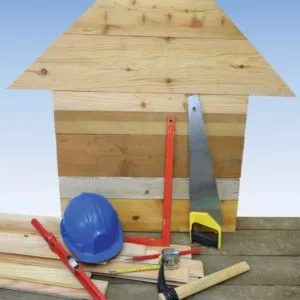Table of Contents
Clawing Back
Remodeling Industry Could See Record Spending in 2015
By Jim Leute
The nation’s home improvement industry is strong and getting stronger, clawing back from a recession that hammered both it and the broader housing market.
In fact, one respected industry watchdog says that while residential construction is still years away from a full recovery, the home improvement industry could nail record spending in 2015, surpassing the $324 billion spent in  2007.
2007.
Noteworthy in that for product manufacturers, specifiers and contractors is the broader extent of remodeling projects and the depths to which homeowners are willing to dive into their wallets to pay for them.
“Basic maintenance and repair projects don’t change that much, and they still happen during even the worst of downturns,” said Abbe Will, a research analyst in the Remodeling Futures Department of the Joint Center for Housing Studies at Harvard University.
“What we’re seeing now is spending on those larger discretionary projects that could be deferred during the downturn.”
As the economy continues to improve and house prices recover, owners are spending more on discretionary work that generally includes significant, lifestyle-improving projects such as additions and kitchen and bath remodels, Will said.
The U.S. remodeling market was just under $300 billion in 2013, according to a recent report from the Harvard group. The market comprises four segments: owner improvements, owner maintenance, rental improvements and rental maintenance.
Owner improvements are easily the largest segment, accounting for $192 billion of the $300 billion overall market. Spending on discretionary home improvements – a subset of the owner improvement category – rose by almost $6 billion between 2011 and 2013, the first increase since 2007.
In 2013, discretionary spending on kitchen and bath upgrades contributed 17 percent of the $192 billion homeowners spent on improvements. Additions and major structural alterations added another 13 percent. Exterior replacements, system upgrades, property improvements, interior replacements and disaster repairs rounded out the category, according to the Harvard group.
To understand the remodeling market today, a brief recap of the Great Recession is necessary
As the housing market crashed beginning at the end of 2007, many homeowners were unable to build new or move up to more desirable single-family homes.
Instead, they opted to remodel their homes, Often, that involved little more than basic maintenance and necessary repairs.
The sector got a boost from federal and state stimulus programs that rewarded energy efficiency. Rental property owners also improved properties for former homeowners who were foreclosed upon or were nervous about buying into the market.
While the U.S construction industry is recovering, 2014 estimates put spending on home building at less than 50 percent of pre-recession levels.
The remodeling sector, however, dropped only 13 percent from peak to trough.
The home improvement industry is faring better because of routine maintenance and repair spending, as well the increase in spending on larger projects.
“From about 2009 on, the residential remodeling sector really saved the industry in some respects,” said Stephen Melman, director of economic services for the National Association of Home Builders.
The National Association of the Remodeling Industry recently reported that 67 percent of remodelers nationwide are experiencing growth. Only 15 percent are reporting declines. Seventy-three percent expect increased business in the short term.
“There has been long-term improvement in sales value, which indicates that larger projects are making a comeback,” said Tom O’Grady, chairman of NARI’S strategic planning and research committee and a builder based in Drexel Hill, Penn.
“Consumers are feeling that the economy will be good for the foreseeable future.”
Will and Melman said investment in the nation’s housing stock is expected to improve as prices for single-family owner-occupied and rental properties continue to increase.
“Remodeling is good now, and it will get better as there are more new homes out there that eventually need to be remodeled,” Melman said. “We’re at a very healthy stage right now.”
Melman’s group is forecasting 737,000 single-family housing starts this year. The group predicts a jump of 40 percent in 2016.
Even with the significant increase forecast for 2016, the number of single-family housing starts would be about 57 percent of the 1.8 million starts posted in 2006, the high-water mark of the last 10 years.
“When housing does well, particularly in sales, there is a lot of remodeling,” Will said. “Sellers spend money getting a house ready for market, and buyers then spend more money improving it to their liking.”
The remodeling industry is highly fragmented, with larger shares of self-employed contractors and small-scale, single-location payroll businesses, Will said.
Many of them are former home builders forced to abandon their primary business during the downturn and focus on remodeling to keep crews working.
Some are forming relationships with manufacturers and retailers that position them as “preferred” installers and providers of specific products and services.
“There’s a certain degree of specialization that’s going on that was brought about by the recession,” Will said. “That’s certainly an evolving niche.”
Will said manufacturers and contractors have several opportunities for growth.
Members of the retiring Baby Boom generation already are boosting demand for accessibility improvements that will allow them to stay in their homes as they age.
Growing environmental awareness also holds promise for sustainable home improvements.
“A lot of the building product manufacturers spent money on research and development and are poised with a lot of neat products,” Melman said. “You want flooring? What kind of flooring? You want countertops? There are now so many options, so many designs, and most are easily installed or applied, less expensive and don’t have the maintenance issues.
“When a remodel is done by a qualified company that uses good design and good quality, owners are generally very pleased with the results.”
Millennials, those born between 1985 and 2004, present a huge growth market, Will said.
“Initially, we expect them to create a surge in the do-it-yourself market, which is a function of age and income,” she said. “But we also expect to see them in the green market.
“Based on some small-scale surveys, we’re hearing from contractors that they’re doing more of that type of work.”
Growth in the remodeling sector, particularly as it relates to green initiatives, is important to the composite panel industry, a hallmark of which is the use of recycled materials.
Chris Herbert, managing director of Harvard’s Joint Center, said it’s only a matter of time before millennials become more active in the housing market and fuel growth in home improvement spending for decades.
Melman said the interests of millennials are not dissimilar to those of their older brothers and sisters.
“Like the Gen-Xers, they want fewer walls, more open spaces, better quality, more light and cooler materials and finishes,” he said. “Energy efficiency is important, as are green initiatives.
“So, too, is storage and organization. They want places to hide all that clutter.”
Overall, NARI’s O’Grady said all the indicators point to slow, steady growth in the remodeling industry.
“The majority of remodelers are seeing growth and are confident that the market is improving,” he said. s&p
“It's only a matter of time before millennials become more active in the housing market and fuel growth in home improvement spending for decades.”
Chris Herbert,managing director of harvard's joint center
Source of graphics:
Harvard Joint Center for Housing Studies, "Emerging Trends in the Remodeling Industry 2015," www.jchs.harvard.edu. All rights reserved.






